Cult Figures - Interview
by John Clarkson
published: 7 / 4 / 2021
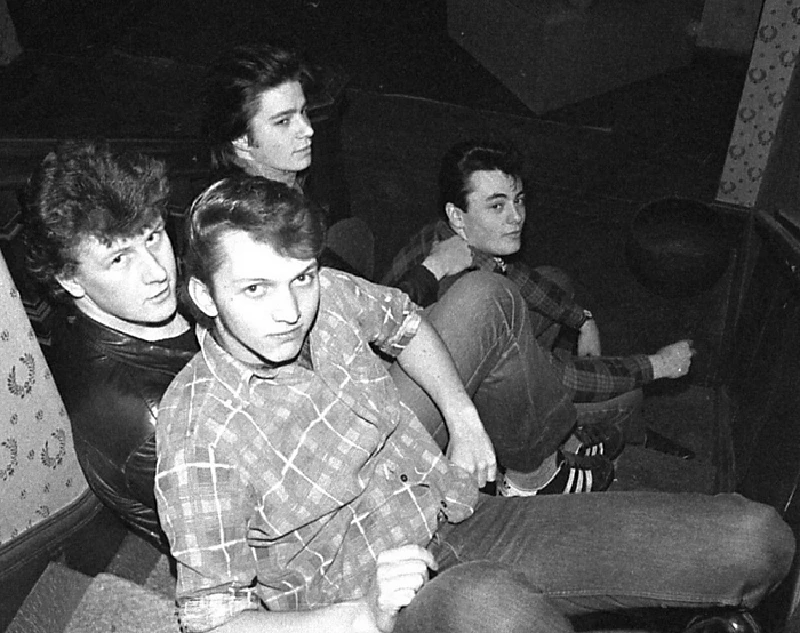
intro
Gary Jones, Jon Hodgson and Lee McFadden from post-punk band Cult Figures speak to John Clarkson about their reformation after an absence of 36 years and new album ‘DerItend'.
With its front cover photograph of a huge mound of rubble set against a desolate Birmingham landscape, Cult Figures on ‘Deritend’ have produced one of the most striking pieces of cover art of the year so far. Cult Figures was formed in Birmingham 1977 by two teenage Art and Design students at Solihull Technical College, guitarist Jon Hodgson and vocalist Gary Jones. They put out two classic releases, a single ‘Zip Nolan’ (1979) and an EP ‘In Love’ (1980) on Rather Records, the label of early indie act Swell Maps, whose members Nikki Sudden and Epic Soundtracks served as a backing band on the first of these before Hodgson and Jones recruited .Martin Hughes (bass) and Alan ‘Jock’ Rodger into the line-up. When a proposed third single which was due to come out on Rough Trade was shelved, Cult Figures, however, broke up. It took 36 years for Hodgson and Jones, who were now both based in London and who had remained friends, to reform Cult Figures in 2016. Their debut album, ‘The 166 Ploughs a Lonely Furrow’, which takes its name from the number of the bus they both used to get to college, came out in 2018, and features new members, Cult Figures’ ‘super fan’ and bassist, Alternative TV’s Lee McFadden; Stuart Hilton (drums) and Barney Russell (guitar, omnichord, percussion). While ‘The 166 Ploughs a Lonely Furrow’ features material written but never recorded in the band’s original lifetime between 1977 and 1980, ‘Deritend’, which came out in March, consists of entirely new songs. It cements the band’s unique blend of pop, punk and psychedelia, and is a ten song set of taut, punchy, often anthemic numbers. Its tracks include ‘Chicken Bones’, which is about the monotony of Friday and Saturday nights on the town and the debris of the morning after; ‘Donut Life’ about a dead-end job; ‘Julie-Anne’, which reflects on a romance on the edge of falling apart; ‘Silver Blades’ which tells of a murder at an ice rink in Birmingham in the 1970s, and ‘Camping in the Rain’ which is a hilarious account of a disastrous family camping trip. Pennyblackmusic spoke to Jon Hodgson, Gary Jones and Lee McFadden about ‘Deritend’. PB: You had been away for 36 years when you reformed in 2016. Why did you decide to get back together when you did and after your previous small but perfect recording career with the ‘Zip Nolan’ single and ‘In Love’ EP. Was it a case of unfinished business? Did it feel like you were taking a risk? Jon Hodgson: Cult Figures’ acrimonious split in 1980 was largely due to frustrations over our musical inability and disillusionment after our mates and mentors Swell Maps split up, bringing an end to our hopes for a third single on Rough Trade. After the break-up, we all carried on doing music in one way or another, sometimes together, sometimes with other bands, but over the intervening years the Cult Figures flame never completely burned out. In 2016 when Gary moved back to London, we met up and over one too many beers the idea of a Cult Figures reunion was mooted and we said: “Why not? Let’s do it!”. Playing the old songs again turned out to be so much fun that we decided to resume gigging and started writing new songs. There was no obvious risk as we really had nothing to lose. Cult Figures never took themselves too seriously anyway so we weren’t bothered about what people would think of a bunch of blokes in their fifties resuscitating a DIY punk band after 36 years. Gary Jones: ...and as we went on, we realised that the new songs were good, and we had a renewed passion for writing and playing. It was still fun, but we had unfinished business! PB: You were backed on those early releases by Swell Maps, who put out both releases on their Rather label. What are your memories of the late Nikki Sudden and Epic Soundtracks? GJ: I met Kevin at an Arts Foundation course at Solihull Tech. We were all so young and, uh, silly really...life was one big joke. Kevin was kind of shy, funny and mad about music, Krautrock featured largely I recall. I didn’t even know he was in a serious band at first, Swell Maps was born and Kevin became Epic! We saw each other every day at college and after we all dispersed we only met up sporadically. I think Jon kept in touch by letter, but I was hopeless at that kind of thing. Nikki was a more mysterious character, I think he was already living in London, but he would drop in every now and then. We got on okay. I was fascinated by his meticulous record collecting. I think he was buying two copies of every punk 7” he liked, one was never played, and one copy was played once and recorded to tape! My records were just played to death! Nikki and Epic (and Jowe Head) were very generous and encouraging towards Cult Figures. Getting to record ‘Zip’ with Maps backing was like a dream, and getting to record the ‘In Love’ EP as a full band was the icing on the cake! JH: We were all studying art together and I remember Kevin (Epic) as a sensitive, complicated, androgynous and slightly vulnerable young man. He had this surreal sense of humour, which was very infectious and filtered into everything he did. He was perversely proud of the fact that he was probably the worst at drawing out of all of us, but somehow managed to produce the best art. He was a true artist and quite an inspiration to the rest of us. His brother Adrian (Nikki) was more confident and worldly. Friendly, but slightly aloof, perhaps because at 21 he was about four years older than we were. He was certainly a bit more of a hipster than Epic and a very early punk rock disciple. PB: You were very young when you released ‘Zip Nolan’ and ‘In Love’. What do you make now of the two young men that wrote and recorded those releases? GJ: Jon and I were very young with no responsibilities, and everything was a laugh. With hindsight I wonder what would have happened if we had gotten a bit more serious and pushed on with the band. I would have loved to do a tour, or at least played many more gigs. No regrets though. We came through okay and Jon and I are still best mates, but I think we are a bit more focused these days! JH: We were excitable, naive, stupid, very rude and badly behaved, just like any other 18 year olds really. I would probably find the person I was back then quite annoying if I met him now, and likewise I’m sure my 18 year old self would not be happy to meet the person he would one day become. PB: Your debut album ‘The 166 Ploughs a Lonely Furrow’ consists of material that you wrote back in the late 1970s. Was it always your intention after you reformed and as you have done with ‘Deritend’ to release new material, or was there no plan initally other than to play a few gigs and to see how it went? GJ: When we got back together we decided to rehearse with songs we all knew as a warm up. Even though new tunes were gushing from Jon’s fingers, we decided that many of the old songs were still good and we wanted them to be heard by a new audience as well as an old one. This desire evolved into the ‘lost album’ concept, which was basically the album we would have made back in 1980/81, but rearranged, rehearsed, and better! We were definitely not ready to go into a studio to record the whole album, but Jon removed that obstacle by recording live backing tracks in rehearsal into Garageband on his laptop. These tracks could then have guitar overdubs, vocals etc added at a later date. This was probably a good way of working as Martin Hughes and soon followed by Alan ‘Jock’ Rodger dropped out for geographic and personal reasons. Lee McFadden was recruited as bass player, and Stuart Hilton joined us on drums, which is why the ‘166’ album has different line-ups on the credits. With the addition of multi-instrumentalist, Barney Russel, we were beginning to knit into quite a tight live unit too, and every gig we just got better and better. PB: Why did you decide to name your album after an industrial suburb in Birmingham? Were you brought up near or around there? GJ: I spent the first eighteen months of my life in Bolton Road, Small Heath less than a mile from Deritend. A few years later we moved to Chelmsley Wood, an overspill development on the edge of Birmingham. In my early teens I would get the bus ‘into town’ to visit Reddington’s Rare Records to pick up early T.Rex and Slade 45s, Nelson House outfitters and the Oasis Market, to pick-up the fashions of the day, which for me definitely erred on the side of casual/football hooligan styles...with a dash of Glam Rock. The bus route terminated in Deritend, but it was the earlier damp, winding cobbled roads, and the sooty industrial brickwork and railway arches which fascinated me as such a contrast with a modern city centre. The name DERITEND lodged itself into my consciousness and was reawakened in the search for an album title! PB: The cover of ‘Deritend’ is a photo of a huge pile of rubble which was taken on a trip back to Birmingham. That could be seen as really black, a statement that nothing is permanent and everything ends, but it could also be seen as more hopeful as it also suggests new beginnings. Was that your intention? JH: The ‘Deritend’ sleeve artwork was a joint effort. Stuart did the layout, but we all contributed photos. Gary and I travelled up to Birmingham to find some interesting images. On the edge of what used to be the old Bullring Centre, we were met with the sight of a vast pile of rubble, dwarfing everything around it. After hours of wandering round the backstreets with our cameras, that rubble pile still resonated as the most powerful image we had seen so we went back to photograph it. It seemed to symbolise all that was left of the old, smoke blackened industrial Birmingham that we grew up in. A transient image of present day urban regeneration; ancient bricks and mortar that would soon be swept away to become landfill and replaced in the near future by anonymous concrete offices and shopping malls, built not for us, but for a new generation of Brummies. The old Birmingham and the people who grew up on those shabby streets will soon be gone and forgotten along with the music. But that’s not such a terrible thing really. That’s just life. PB: The differences between now and then and the way things have changed and also stay the same seems to be one of the main themes of ‘Deritend’. You sing “these streets look different but they all smell the same” as a punch line on the opening track ‘Chicken Bones’, and ‘Concrete and Glass’ is about the regentrification and destruction of the character of London’s Soho and West End. Was that always going to be inevitably a major theme, given that you have been away for so long? GJ: Ha! It was never an inevitability because we’d been away so long, but rather that we had been around so long!! JH: The songs on the album are a reflection of the lives we are living now. The 4 a.m. journeys through squalid streets filled with drunken clubbers, to a dead end job, ears still ringing with tinnitus from the bands we saw a quarter of a century ago. The world has changed, but the human condition hasn’t altered, the same old lies from the profligate leaders and the endless struggle to keep hope alive in the face of an uncertain future. And the memories of our shared past looming large, as what goes around comes around again and again. PB: On the subject of hope, ‘Donut Life’ is about trying to survive the routine of a dead end job in a bakery in a supermarket. ‘Lights Out’ seems to be about blocking out anxiety and depression, and, despite you whistling at one point, you sing on that track, “I don’t want to see the darkness in my mind.” The narrator of ‘Julie-Anne’ also suspects that he is getting the run around from the title character but prays that he is not. Do you see the other main theme of ‘Deritend’ as being about finding hope against impossible odds? GJ: It has to be really, because without hope what do we have left? JH: While the Titanic was sinking the band played on. What better thing is there to do than keep playing music, for as long as you can? Music is hope, an escape from grim reality, where together through some miraculous alchemy, we manage to create something meaningful from all the bewildering crap that life throws at us. PB: ‘Silver Blades’ is about a murder at an ice rink in Birmingham in the late ‘70s. Was that based upon a real incident? GJ: I like that ‘Blades’ resonates with listeners as a true story. It shows that we tapped into something that a lot of people recognise. The lyrics are based on a scrapbook of half memories, about teenage crushes and fears, from a sense of menace and violence which was actually palpable in places like Silver Blades on a Friday night. Teenage turf wars were a real thing, and I had heard of ice skate blades being used in fights. PB: You won awards for the video for ‘Lights Out’, and the video for ‘Chicken Bones’, which was directed by Jon and is also really good, shows Gary wandering around working class neighbourhoods of London. Do you have plans to create videos for the other tracks on the album, and will Jon be directing again? JH: The ‘Lights Out’ video was shortlisted for best music video at the 2020 London International Animation Festival, although it didn’t actually win. Nonetheless, it was great exposure for the band and nice for our music to be heard by a different audience. We have already released two other videos: ‘Silver Blades’ again by me and ‘Camping in the Rain’ by our drummer Stuart who is also an animation director. I made a video for ‘Concrete and Glass’ during the first lockdown and we will be releasing that one soon. If I had time I’d make a video for every song on the album, because it really does help to spread the word. PB: ‘Deritend’ was recorded at Toerag Studios with Liam Watson in London and Woodbine Street Studios with John Rivers. What do you feel that working and recording at those studios brought to the album? LEE MCFADDEN: We recorded at Toerag in June ’19 and Woodbine in February last year. With the new line up we have been gelling as friends and also as a live unit. We were pretty tight musically going into Toerag, and even more so on the visit to Woodbine. Even though as memory serves me our methods at both studios were similar and the recording time we had was roughly the same, somehow it felt as if we had more to play with at Woodbine. It felt like a greater productive experience there – at Toerag for me personally it didn’t feel a lot different to playing the songs on stage. JH: We recorded ‘The 166’ on Garageband because it suited the DIY aesthetic and because we couldn’t afford anything else really. Since then we saved up a bit of money from gigging and record sales so for ‘Deritend’ we decided to push the boat out a bit further. Stuart and I had recorded at Toerag before and loved the authentic vintage sound from the old valve equipment there. We recorded more than half the album there, but studio boss Liam Watson wasn’t available to finish the album in time so we did the other five songs at Woodbine St in Leamington Spa, where we recorded our first two singles in 1978-80. John Rivers who owns the studio is a lovely bloke and one of the best producers in the business. Toerag’s distinctive sound set the style for the album, but John’s amazing mixes gave it that extra power, energy and polish. PB: What plans do you have for the future? Will you be playing gigs and will there be a third album? LM: We are arranging gigs now. We are chomping at the bit to play live. Obviously the whole situation is dependent on how things progress with this dark version of lockdown hokey cokey that we are all experiencing but we all are crossing fingers for a return to normality. As for the "difficult" third album - well, you won't have to wait 40 years! JH: We’ve got enough new songs for another two albums at least. We just need the all clear to start rehearsing and recording again. GJ: We have to play live music again! And yes there will be a third album! PB: Thank you.
Band Links:-
https://www.facebook.com/CultFigures/https://twitter.com/cultfigures1?lang=en
https://cultfigures.bandcamp.com/
Play in YouTube:-
Have a Listen:-
Picture Gallery:-
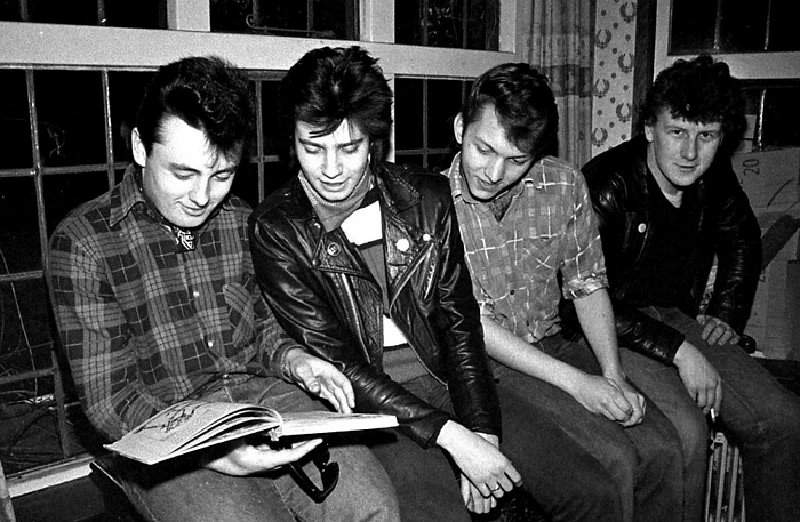
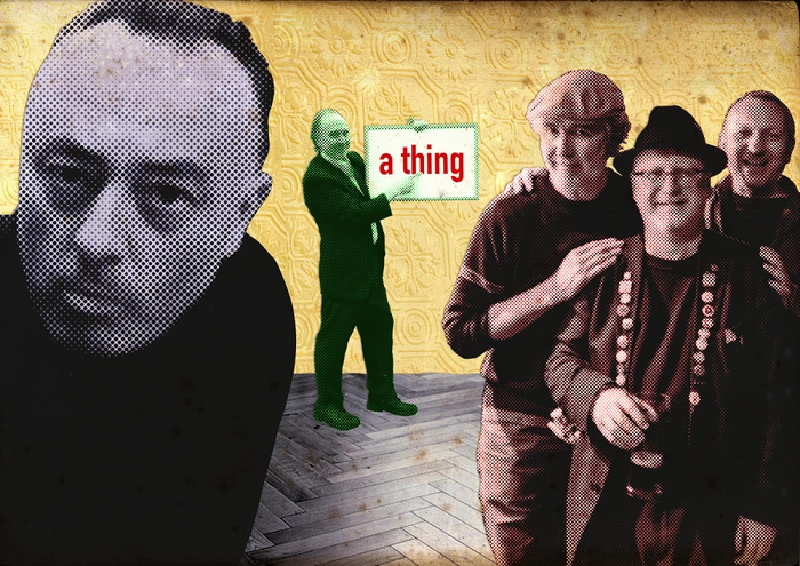
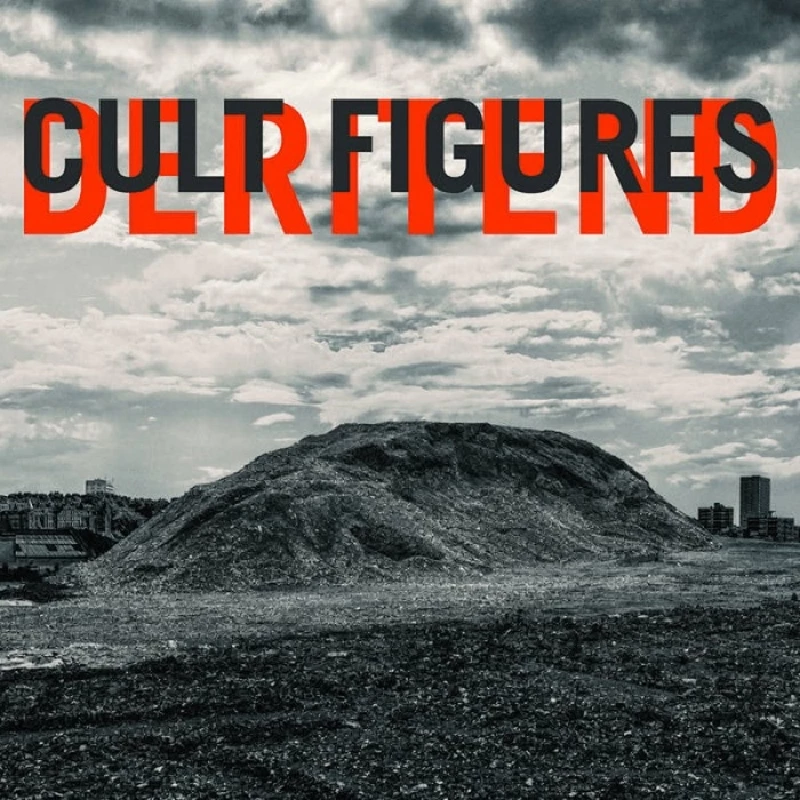
bandcamp
soundcloud
reviews |
|
Between Us and Heaven (2024) |
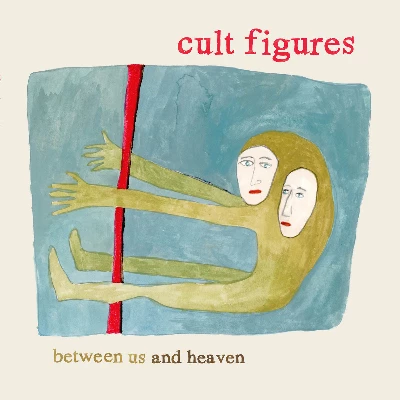
|
| Excellent post-punk on third album from Midlands-formed band Cult Figures |
most viewed articles
current edition
Spear Of Destiny - InterviewRobert Forster - Interview
Fiona Hutchings - Interview
When Rivers Meet - Waterfront, Norwich, 29/5/2025
Carl Ewens - David Bowie 1964 to 1982 On Track: Every Album, Every Song
Brian Wilson - Ten Songs That Made Me Love...
Chris Wade - Interview
Pistol Daisys - Waterfront, Norwich, 29/5/2025
Credits - ARC, Liverpool, 17/5.2025
Gary Numan - Berserker
previous editions
Heavenly - P.U.N.K. Girl EPBoomtown Rats - Ten Songs That Made Me Love....
Barrie Barlow - Interview
Manic Street Preachers - (Gig of a Lifetime) Millennium Stadium, Cardiff, December 1999
Oasis - Oasis, Earl's Court, London, 1995
Dwina Gibb - Interview
Pixies - Ten Songs That Made Me Love...
David Paton - Magic: The David Paton Story
Chuck Prophet - Ten Songs That Made Me Love...
Sound - Interview with Bi Marshall Part 1
most viewed reviews
current edition
Peter Doolan - I Am a Tree Rooted to the Spot and a Snake Moves Around Me,in a CircleGarbage - Let All That We Imagine Be The Light
Vinny Peculiar - Things Too Long Left Unsaid
Little Simz - Lotus
John McKay - Sixes and #Sevens
Suzanne Vega - Flying With Angels
HAIM - I Quit
Morcheeba - Escape The Chaos
Vultures - Liz Kershaw Session 16.06.88
Billy Nomates - Metalhorse
Pennyblackmusic Regular Contributors
Adrian Janes
Amanda J. Window
Andrew Twambley
Anthony Dhanendran
Benjamin Howarth
Cila Warncke
Daniel Cressey
Darren Aston
Dastardly
Dave Goodwin
Denzil Watson
Dominic B. Simpson
Eoghan Lyng
Fiona Hutchings
Harry Sherriff
Helen Tipping
Jamie Rowland
John Clarkson
Julie Cruickshank
Kimberly Bright
Lisa Torem
Maarten Schiethart